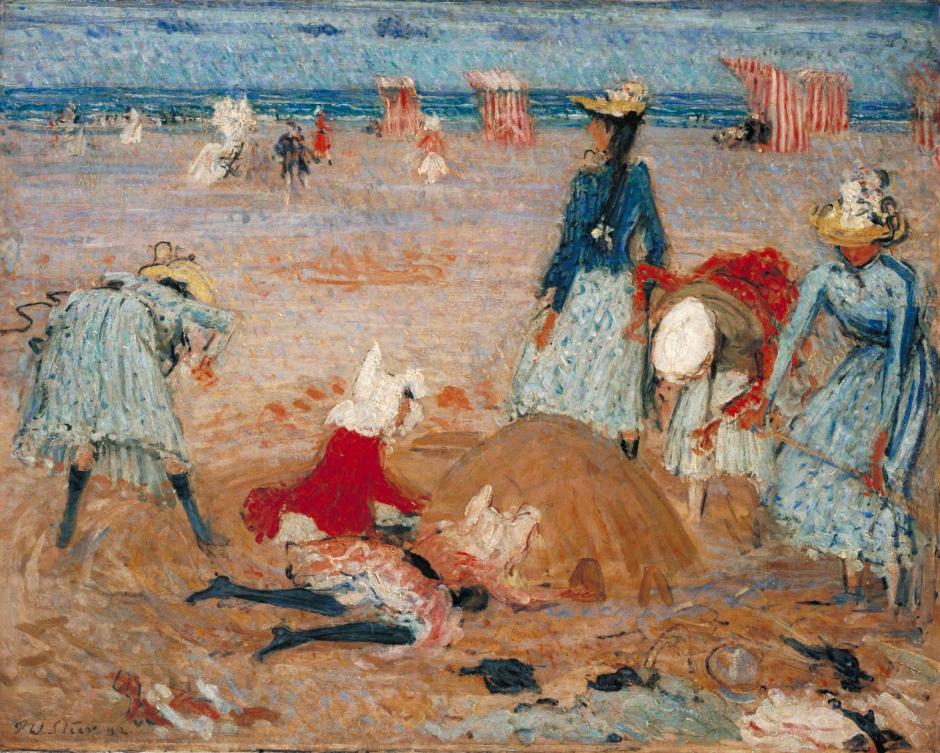By all accounts, however influential Whistler and Sickert might have been, the first and most dominant British Impressionist painter was Philip Wilson Steer (1860-1942). He trained in Paris between 1882-84, initially under Bouguereau at the Académie Julian, then at the École des Beaux-Arts, from where he was successful in exhibiting at the Salon in the Spring of 1884.
When he was in France, Steer became influenced by the Impressionists, and attempted to assimilate their techniques and style in his own painting, particularly from about 1887. However, it’s not clear how well he was exposed to contemporary Impressionist painting: while he was studying in Paris, the only places in which he could have seen original Impressionist art were in the city’s commercial galleries such as those of Durand Ruel. Ironically, it was during a short visit to London in 1883 that he is most likely to have attended a substantial exhibition of Impressionist paintings, again organised by Durand Ruel.

His early works, from around 1887, seem to have been painted on the beaches of northern France, including Children Paddling, Étaples (1887) above, and Boulogne Sands (1888-91) below. They are bright, high in chroma, and they appear to have been quick oil sketches painted en plein air during the summer.


The following summer, Steer visited Cowes at the northern tip of the Isle of Wight, England, where he painted one of his most Impressionist paintings, Summer at Cowes. This compares with many of the coastal views painted by Sisley and Monet during the 1870s and early 1880s.

In the late 1880s, Steer was regularly visiting the coast of north Suffolk, painting in two small but popular resorts, Walberswick and Southwold, which are only a mile apart. Among the scenes he painted there are Girls Running, Walberswick Pier (1888-94), above, and the next two works. Originally, the two girls were shown to be holding hands, but Steer reworked that only to leave their shadows with their hands together.
In the autumn of 1888, Steer was the leader of a breakaway group from the New English Art Club which styled itself the London Impressionists. Their only exhibition was held at the Goupil Gallery in London in December of that year. Steer also exhibited five paintings at Les XX in Brussels, Belgium.

The Beach at Walberswick above, and Southwold below, are believed to have been painted in about 1889.

Around 1888, Steer met Rose, the youngest of the Pettigrew sisters who had celebrated careers as models. By about 1891, she was Whistler’s most frequent choice of model, often working five days a week with him, and lunching with him and his wife Beatrice. She also modelled for William Sickert and Augustus John.

There’s dispute over the year in which Steer painted this portrait of her; it could have been as early as 1887, when she would have only just been fifteen, but it’s more likely to have been in 1892, by which time she would have been twenty and apparently had fallen in love with Steer.

Steer continued to paint her in works such as The Japanese Gown (1896). Nothing seems to have come of that, Steer died a bachelor, and this is the last painting of his in which she appears. That year, Rose married the composer and musician Harry Waldo Warner, and put modelling behind her.
From 1893, while most of his paintings remained unsold, Steer started to teach painting at the Slade School of Fine Art, London, alongside his friend Henry Tonks, and to visit locations made famous in Turner’s work, and paint there. By this time, his dominant influences were Turner and Constable.

From 1896 he undertook more portraits, in which he was obviously influenced by the Rococo. Then after 1902 he concentrated on watercolour, and returned to landscapes.

In 1907, Steer returned to France to visit the Cézanne memorial exhibition. He stayed at Montreuil-sur-Mer near the Channel port of Calais, where he painted this view of The Church at Montreuil (1907).

The following year, he continued to paint in Impressionist style with this view Under the Trees (1908), which is reminiscent of Monet’s paintings of trees in the south of France.
In 1929 he had a major retrospective at the Tate Gallery, London, its first to be devoted to a living painter. The following year he retired from teaching at the Slade School of Art.

Steer remained close friends with Henry Tonks and Walter Sickert. Tonks’s Sodales – Mr Steer and Mr Sickert (1930) shows Steer dozing when Sickert was visiting him at home in Cheyne Walk, London.
Philip Wilson Steer died in 1942, and the following year was commemorated by an exhibition at The National Gallery, London.
Philip Wilson Steer:
Wikipedia
Munro J (1986) Philip Wilson STEER 1860-1942. Paintings and Watercolours, Arts Council of Great Britain. ISBN 0 7287 0484 6. (A small catalogue, long out of print, seems to be the only literature on him which is readily available on the secondhand market. Limited colour reproductions.)

